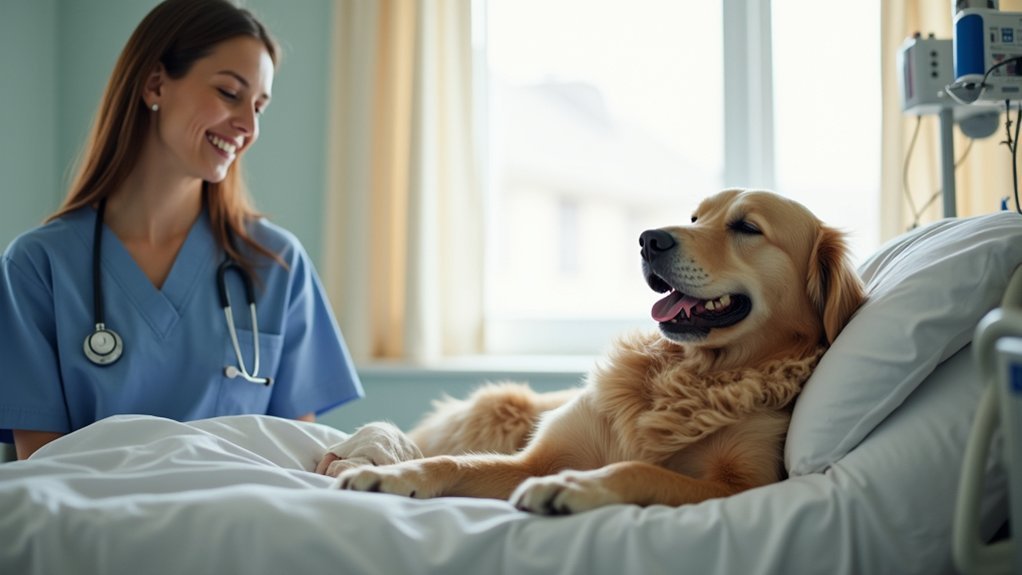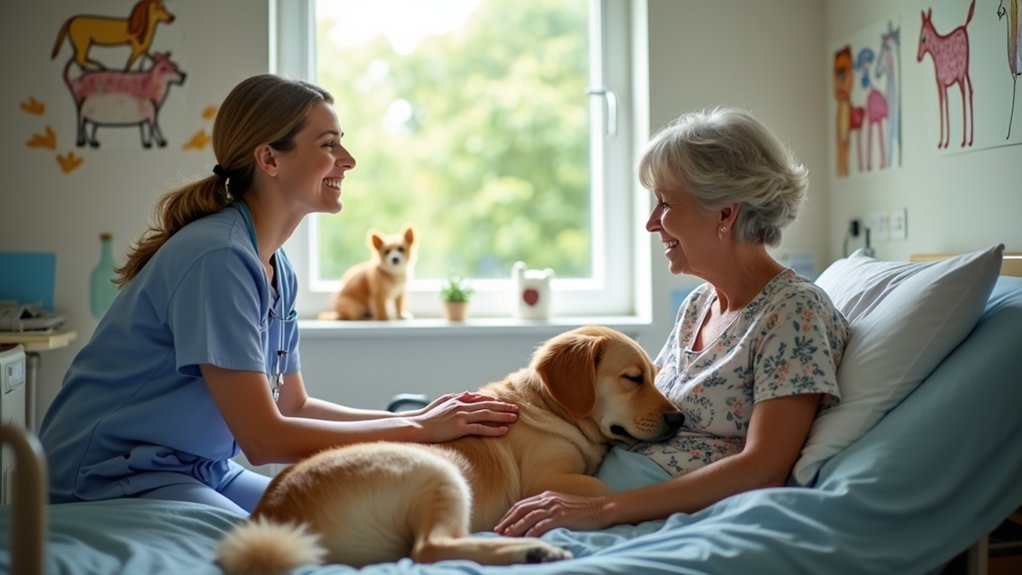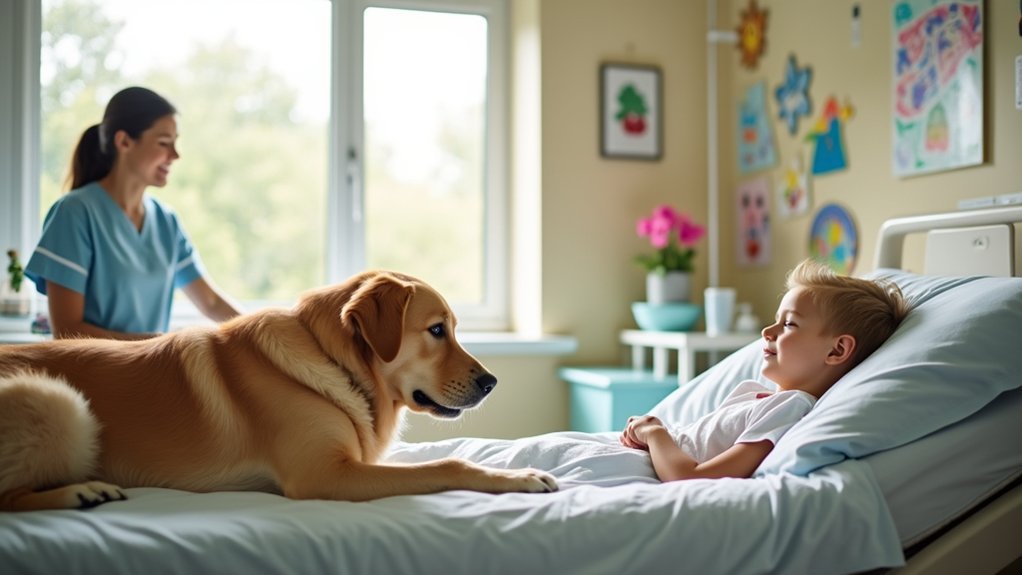Hospital animal therapy greatly transforms patient recovery by triggering the release of mood-enhancing chemicals like oxytocin and serotonin. You’ll experience decreased pain levels, with 22.6% of patients reporting meaningful relief during animal interactions. These furry visitors create warmer healthcare environments, reduce stress hormones, and combat loneliness – even healthcare workers report nearly doubled mood improvements. Therapy animals also serve as social bridges, enhancing communication for patients with various conditions. The healing power of these interventions extends far beyond simple companionship.
The Science Behind Animal Therapy’s Mood-Boosting Effects

While many people intuitively understand the joy of interacting with animals, the science behind animal therapy reveals a complex neurochemical foundation for these mood-boosting effects.
When you interact with therapy animals, your brain releases serotonin, improving your mood and reducing depression symptoms. Simultaneously, oxytocin levels rise, promoting feelings of relaxation and bonding.
Your brain also produces prolactin, which contributes to a calming effect and enhances mood stability. Like eating chocolate, interacting with therapy animals triggers phenylethylamine release, creating a sense of well-being. Research from The Ohio State University shows that health care workers experienced self-reported mood improvements that nearly doubled after brief interactions with therapy dogs.
These neurochemical changes collectively reduce stress hormones, creating an ideal recovery environment.
This biochemical cascade explains why you’ll likely experience reduced anxiety, elevated mood, and improved cognitive function when participating in animal-assisted therapy sessions—transforming your hospital experience through measurable physiological responses.
Pain Management Through Furry Companions
When hospital patients engage with therapy animals, a remarkable transformation in pain perception often occurs. Clinical studies show that about 22.6% of patients experience meaningful pain relief through these interactions, with benefits extending to both adults and children.
You’ll find this works through multiple mechanisms. The distraction of petting or playing with a therapy animal shifts your focus away from discomfort, while the emotional bond triggers chemical changes in your body that naturally reduce pain.
Additionally, therapy animals create a relaxing environment that lowers anxiety—a key contributor to pain intensity. Post-surgical patients interacting with therapy dogs have shown lower pain ratings and improved participation in rehabilitation activities.
Whether you’re recovering from surgery or managing chronic pain, these trained animals offer complementary support to traditional treatments, with effects ranging from reduced pain scores to decreased anxiety and depression.
Transforming Hospital Environments With Animal Visitors

You’ll notice an immediate shift when therapy animals enter hospital hallways, transforming sterile spaces into warm, healing environments where stress melts away.
These furry visitors break down barriers between staff and patients, creating natural conversation starters and shared moments of joy. The emotional bond formed during these interactions helps addiction recovery patients experience reduced anxiety symptoms and improved mental health outcomes.
Beyond decoration or distraction, animal therapy programs represent a fundamental reimagining of healthcare spaces that prioritize emotional wellbeing alongside medical treatment.
Creating Healing Spaces
Beyond providing medical treatment, hospitals can become true healing environments through the introduction of animal therapy programs. When therapy animals enter a patient’s room, they transform sterile clinical settings into warmer, more humanizing spaces.
You’ll notice immediate benefits as patients experience reduced pain perception and lower cortisol levels during animal interactions. These furry companions create therapeutic atmospheres where emotional regulation becomes easier and stress diminishes noticeably.
The healing effect extends beyond individual patients, as therapy animals encourage social interactions among patients who might otherwise remain isolated. Research shows that therapy dogs specifically help ICU patients at risk of developing anxiety and depression.
Even intensive care units can implement animal-assisted therapy, bringing comfort to the most critical settings. By incorporating animals into the hospital environment, you’re supporting a holistic approach to recovery that addresses emotional wellbeing alongside physical healing.
Reducing Institutional Stress
The clinical, sterile environment of hospitals often contributes greatly to patient and staff stress levels, creating what healthcare professionals term “institutional stress.”
Therapy animals serve as powerful stress-reduction agents in these settings, transforming cold, impersonal spaces into more comforting environments.
When therapy animals visit, you’ll notice immediate physiological changes—decreased heart rates, lower cortisol levels, and reduced pain.
These benefits extend beyond patients to healthcare workers, who report considerably lower stress levels and improved morale after animal interactions.
You’ll also observe remarkable behavioral shifts: previously withdrawn patients engage socially, while staff experience less burnout.
Animal therapy disrupts monotonous hospital routines, stimulates positive emotional responses, and creates sustained mood improvements—all without medication.
This non-pharmacological approach makes institutional environments feel less clinical and more conducive to healing.
Research confirms that AAT offers a valuable complementary therapy option that can work alongside traditional treatments for various mental health conditions encountered in hospital settings.
Staff-Patient Connection Catalyst
While reducing institutional stress benefits individual experiences in hospital settings, therapy animals also serve as powerful mediators in human relationships. They create a communication bridge between you and your healthcare providers that might otherwise be difficult to establish.
You’ll find these animals break down barriers naturally—when a therapy dog enters your room, the clinical atmosphere transforms into something warmer and more approachable. This change encourages you to open up to staff more readily.
Your anxiety decreases in the animal’s presence, making instructions from medical personnel easier to process and follow.
Meanwhile, staff experience reduced burnout and increased job satisfaction when working alongside therapy animals, enhancing their capacity for empathetic care. This mutual benefit creates a positive feedback loop of improved communication and trust.
Reducing Cardiovascular Stress One Paw at a Time

As patients recover in clinical settings, their cardiovascular health often faces significant challenges due to stress, anxiety, and the sterile hospital environment. Animal-assisted therapy offers a natural solution to this problem. When you interact with therapy animals, your body responds with measurable cardiovascular benefits—your blood pressure decreases, heart rate slows, and stress hormone levels drop. The American Heart Association has concluded that interaction with animals is associated with reduced cardiovascular disease risk, making therapy animals particularly valuable in hospital settings.
| Cardiovascular Benefit | How Animals Help |
|---|---|
| Lowered Blood Pressure | Petting calms nervous system |
| Reduced Heart Rate | Animal presence promotes relaxation |
| Decreased Stress Hormones | Positive interactions trigger oxytocin release |
These physiological changes aren’t just temporary. Regular therapy animal visits can contribute to improved long-term cardiovascular outcomes, especially for heart failure patients. Your recovery becomes more comfortable and potentially faster when these four-legged healers become part of your treatment plan.
Breaking Social Isolation With Therapy Animals
Beyond the physical health benefits, hospital animal therapy addresses another critical healthcare challenge—social isolation. When you’re hospitalized, particularly as an older adult, loneliness can profoundly impact your recovery. Just 20 minutes with a therapy dog can dramatically reduce these feelings of isolation in ways that human contact alone can’t replicate. Research has shown that loneliness affects up to 29% of older adults living in community settings.
For psychiatric patients, particularly those with conditions like schizophrenia, therapy animals serve as social bridges. They’ll help you develop empathy and social skills while creating natural opportunities for interaction with caregivers and other patients.
The animals facilitate conversation without judgment, releasing oxytocin that builds trust and reduces anxiety around social engagement.
While these benefits may require ongoing sessions to maintain, they represent a powerful tool against the growing epidemic of social isolation in healthcare settings.
Enhancing Communication Skills Through Animal Interaction

The gentle presence of therapy animals creates a unique bridge that helps patients overcome communication barriers in hospital settings.
You’ll notice patients interact more freely and expressively when therapy dogs are present, particularly those with autism spectrum disorder or neurogenic communication disorders.
Speech therapists report longer conversation turns and more complex language use during animal-assisted sessions compared to traditional therapy. The non-threatening environment encourages you to share thoughts and feelings you might otherwise keep hidden.
For children with ASD, therapy animals act as social catalysts, stimulating meaningful interactions and developing both verbal and nonverbal skills.
Even patients recovering from stroke or brain injury show increased motivation to communicate when animals are part of their rehabilitation program, reducing anxiety and creating natural opportunities for expression. These short 15-minute sessions are specifically designed to provide enough interaction time without overwhelming patients in their recovery journey.
Motivation and Treatment Adherence: The Animal Connection
When you’re struggling with medical treatments, therapy animals can provide the emotional support that dramatically improves your motivation to continue.
You’ll find yourself more likely to follow through with treatment plans as these furry companions reduce anxiety and create a positive association with healthcare environments.
Animal therapy sessions can transform your recovery journey from a burdensome process into a meaningful experience that you’ll actively engage with. Studies have shown that patients recovering from total joint replacement required 50% less pain medication when participating in canine therapy sessions.
Motivation and Treatment Adherence: The Animal Connection
Animals play a pivotal role in boosting patient motivation during medical treatment, creating a unique connection that healthcare providers are increasingly recognizing as valuable.
When you’re facing health challenges, the presence of a therapy animal can transform your treatment experience.
You’ll likely notice improved mood and reduced stress during animal-assisted therapy sessions, making your treatment environment more comfortable. This emotional support particularly helps if you’re feeling isolated.
The animal-human bond fosters trust between you and your healthcare team, increasing your comfort with treatment procedures.
What’s most impressive is how these interactions enhance your participation in treatment plans. You’ll engage more actively with therapeutic activities, leading to better adherence and ultimately improving your recovery outcomes. Participants have reported they motivated and enjoyed therapy sessions significantly more when animals were present.
AAT complements traditional therapies, making your entire treatment process more effective.
Animals Create Treatment Momentum
Powerful yet often underestimated, therapy animals create a unique momentum in hospital treatment settings that conventional approaches sometimes fail to achieve.
When you’re struggling with recovery, an animal’s unconditional presence can transform your treatment journey by reducing stress and anxiety that often impede progress.
The animal-human bond establishes momentum through:
- Emotional scaffolding – Animals provide support that reduces aggression in psychiatric settings and improves mental health for 74% of those who interact with them.
- Consistent engagement – Regular structured sessions with therapy animals maintain treatment routines and foster vital social connections.
- Purpose-driven recovery – The responsibility of caring for or interacting with an animal instills meaning that propels recovery forward when motivation wanes.
This momentum creates a powerful foundation for sustainable healing and improved treatment adherence. Studies have shown that interaction with therapy dogs can produce significant physiological relaxation in hospitalized patients, complementing traditional medical interventions.
Engagement Through Furry Friends
Despite their silent support, therapy animals have emerged as powerful motivators in hospital settings where traditional treatment methods often struggle to maintain patient engagement.
When you interact with these furry companions, you’ll likely find yourself more willing to participate in treatment routines as they provide welcome distractions from pain and discomfort.
You’ll notice therapy animals naturally boost your energy and alertness—essential qualities for rehabilitation activities. They create a sense of purpose that improves your adherence to prescribed plans.
The non-judgmental presence of an animal reduces your anxiety and stress, making you more receptive to medical advice and more likely to attend therapy sessions consistently. Studies have shown that animal-assisted activities can significantly improve immediate mood benefits for healthcare workers experiencing burnout and stress.
This emotional connection transforms potentially intimidating treatment processes into more approachable, even enjoyable experiences.
Case Studies: Remarkable Patient Recoveries With Animal Support
While medical science continues to advance with cutting-edge technologies, some of the most extraordinary patient recoveries have occurred with the help of four-legged therapists.
These remarkable transformations aren’t just anecdotal—they’re documented across multiple hospital settings and patient populations.
- ICU patients working with therapy dogs achieved rehabilitation milestones faster, including longer standing times and increased physical engagement when traditional methods had plateaued.
- Pediatric patients experiencing severe anxiety during painful procedures showed dramatic improvement in essential signs and emotional well-being after therapy animal visits.
- Rehabilitation unit patients demonstrated heightened motivation and participation in therapy exercises when animals were incorporated, leading to accelerated functional gains.
You’ll find these animal-assisted success stories consistently showcase reduced pain levels, improved mood, and enhanced recovery trajectories—particularly in settings where conventional approaches alone struggled to make progress. Experts now increasingly recommend therapy dogs for use in intensive care units due to their proven effectiveness as nonpharmacological interventions.
Selecting the Right Therapy Animals for Different Patients

Selecting the appropriate therapy animal for each patient requires careful consideration of multiple factors that extend beyond the animal’s training credentials. You’ll find that different patients respond better to specific animals based on their condition, preferences, and specific therapeutic needs.
For best results, healthcare facilities match animals to patients by evaluating health requirements, emotional needs, and physical capabilities. Small, calm dogs are ideal for immunocompromised patients, while larger breeds may better serve physical therapy requirements. Unlike service dogs, therapy dogs work with their owners to improve the lives of individuals during hospital visits.
| Patient Type | Ideal Animal Match | Therapeutic Benefit |
|---|---|---|
| Pediatric | Small, gentle dogs | Reduces anxiety during procedures |
| Geriatric | Calm cats or lap dogs | Provides companionship, reduces loneliness |
| Physical Rehab | Larger, steady dogs | Motivates movement and engagement |
| Psychiatric Care | Emotionally responsive animals | Builds trust and communication skills |
Always consider allergies and phobias when selecting therapy animals for your patients.
Training Requirements for Hospital Therapy Animals
You’ll find therapy animals in hospitals must meet rigorous certification standards through organizations like Pet Partners or Therapy Dogs International before they can visit patients.
Each species requires specific training protocols that address their unique behaviors and potential interactions in medical settings.
The handler-animal bond forms the foundation of effective therapy work, with both receiving specialized training to function as a cohesive team when maneuvering the complex hospital environment. At Children’s Hospital of Philadelphia, therapy dog handlers must commit to a minimum of two-hour monthly shift to participate in their Gerald B. Shreiber Pet Therapy Program.
Rigorous Certification Standards
Before any therapy animal can set foot in a hospital setting, they must undergo thorough certification processes that guarantee patient safety and therapeutic effectiveness.
You’ll find that nationally recognized organizations like Alliance of Therapy Dogs, Therapy Dogs International, and Pet Partners maintain strict standards for animal-handler teams.
To obtain certification, your therapy dog must:
- Be at least one year old and pass rigorous temperament testing that ensures they remain calm around medical equipment and unexpected stimuli.
- Complete detailed health screenings and maintain up-to-date vaccinations against rabies, distemper, and other infectious diseases.
- Successfully perform during supervised visits where both you and your dog demonstrate appropriate handling, obedience, and social interaction skills.
Recertification requirements guarantee ongoing compliance with these standards, as hospitals typically require documentation verifying your team’s credentials before allowing patient interactions.
Remember that therapy dogs must have a friendly temperament that allows them to comfortably interact with strangers in potentially stressful environments.
Species-Specific Training Protocols
While certification standards establish baseline qualifications, the training requirements for hospital therapy animals vary considerably by species. You’ll find that dogs must master calm interactions during unpredictable medical situations, while cats are trained for quieter, lap-based therapeutic visits.
Each animal undergoes species-specific obedience training focused on hospital environments—learning to navigate equipment, respond to diverse patients, and recognize when to engage or withdraw. Training protocols address the unique ethology of each animal, teaching handlers to identify stress signals that might compromise therapy sessions. Handlers must also maintain recognized handling credentials and participate in continuing education to ensure they remain qualified to work with their therapy animals in healthcare settings.
Rigorous health protocols also differ by species, with tailored vaccination schedules and grooming requirements to prevent zoonotic disease transmission.
The animal’s natural abilities guide task training, whether it’s a miniature horse providing mobility support or a rabbit offering gentle comfort during chemotherapy sessions.
Handler-Animal Bond Development
The foundation of effective animal therapy in hospital settings rests on a deep, symbiotic connection between handlers and their therapy animals. This relationship isn’t built overnight—it requires dedicated time and continuous nurturing through shared experiences.
To develop this essential bond, you’ll need to:
- Meet the six-month residency requirement, allowing your animal to integrate fully into your home environment and establish trust.
- Participate in specialized training programs that teach you to read your animal’s behavioral cues and manage various therapy scenarios.
- Engage in regular bond-strengthening activities that simulate hospital environments, preparing both of you for the unique challenges of clinical settings.
This partnership forms the cornerstone of successful therapy work, enabling you to navigate stressful situations while maintaining your animal’s welfare and therapeutic effectiveness. Both handlers and animals must undergo certifications and training to ensure safety during therapeutic interactions in hospital environments.
Implementing Animal Therapy Programs in Medical Facilities
Successful animal therapy programs in hospitals require meticulous planning and coordination among multiple stakeholders.
Hospital animal therapy demands precise orchestration between healthcare teams, therapy organizations, and animal handlers to ensure success.
You’ll need to partner with established animal therapy organizations that already have hospital relationships to optimize logistics and volunteer availability.
Involve clinic leadership early to guarantee the program meets staff and patient needs.
Create clear communication materials—information sheets, calendars, and signage—to establish expectations and schedules.
Your program should include strict infection control protocols, with nurses evaluating patient eligibility based on established criteria.
Designate accountable personnel to oversee visits, maintain location tracking, and manage any incidents that arise.
Regular veterinary examinations and behavioral monitoring are essential for animal welfare.
A comprehensive coding system should be implemented to clearly indicate which rooms permit animal interaction preferences and which present health risks for patients or therapy animals.
Remember to coordinate with hospital services like cleaning staff to maintain appropriate environmental conditions before and after therapy sessions.
Measuring the Impact: Quantifiable Benefits of Animal Therapy
Once your animal therapy program is established, you’ll need to assess its effectiveness through concrete measurements. Research consistently shows statistically notable benefits across multiple health dimensions. Studies using chi-squared tests (p=0.00005) demonstrate clear distinctions between patients who receive animal therapy and control groups.
You’ll find measurable improvements in:
- Mood and Mental Health – Patients report better mood states, with statistical significance at α=0.05 level, particularly when therapy extends through a 15-week cycle.
- Pain and Anxiety Reduction – Participants experience decreased pain levels, reduced pulse rates, and notably lower anxiety scores.
- Quality of Life Enhancement – Patients feel less burdened by their conditions, showing improvements in both rehabilitation outcomes and overall life satisfaction.
These quantifiable benefits make a compelling case for animal therapy as a complementary treatment approach.
The Future of Hospital-Based Animal-Assisted Interventions
As healthcare continues evolving, animal-assisted interventions stand poised for revolutionary changes that will transform how patients experience therapy. You’ll soon see animal therapy programs integrated into mainstream healthcare, with insurance coverage becoming a reality as evidence-based practices solidify their legitimacy. The unprecedented growth in the animal health industry will introduce advanced biologics that enhance therapeutic animal health and safety during hospital interventions.
| Innovation | Impact |
|---|---|
| AI-powered tools | Enhanced therapy assessment and personalization |
| Virtual therapy options | Reaching immobile patients and remote communities |
| Robotic therapy animals | Complementing live animals in sensitive settings |
| Diverse therapy animals | Moving beyond dogs to species matched to needs |
Technology will make these interventions more accessible globally, while standardized training will guarantee consistent quality. Despite resource constraints and regulatory hurdles, partnerships between healthcare providers and animal welfare organizations will drive this therapeutic frontier forward.
Frequently Asked Questions
How Do Hospitals Protect Immunocompromised Patients During Animal Therapy Sessions?
You’re protected through restricted access to immunocompromised areas, pre-visit screening, no direct contact with medical devices or wounds, prevention of animal licking, thorough hand hygiene, and post-visit environmental cleaning and disinfection.
Are There Insurance or Liability Considerations for Animal Therapy Programs?
Yes, you’ll need liability insurance to cover potential risks. Programs typically require professional liability coverage, and you should consider adding facilities as additional insureds per contractual requirements. Many health insurers don’t reimburse for animal therapy.
What Happens if a Patient Has Allergies to Therapy Animals?
If you’re allergic to therapy animals, you’ll be pre-screened and offered alternatives like virtual animal interactions or other therapies. Staff can implement special precautions or separate areas to minimize your exposure to allergens.
How Do Therapy Animals Cope With Stress in Hospital Environments?
Therapy animals cope through specialized training, regular breaks, and handler supervision. You’ll notice they’re selected for calm temperaments and receive stress management techniques. They’re rotated between patients to prevent burnout and maintain their wellbeing.
Can Family Pets Be Certified to Visit Their Owners in Hospitals?
Yes, your family pet can be certified for hospital visits. You’ll need to obtain certification through local programs, provide vaccination records, and follow hospital guidelines. However, there’s no national accreditation standard.
In Summary
You’ve seen how animal therapy transforms patient recovery—from mood enhancement to pain reduction. As hospitals continue embracing these programs, you’re witnessing healthcare’s evolution toward more holistic approaches. Whether it’s lowering your stress levels or breaking your social isolation, therapy animals offer measurable benefits that complement traditional treatments. By supporting these initiatives, you’re helping create healing environments where patients don’t just recover—they thrive.





Leave a Reply